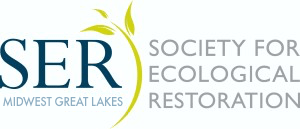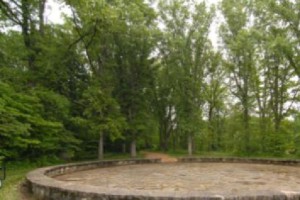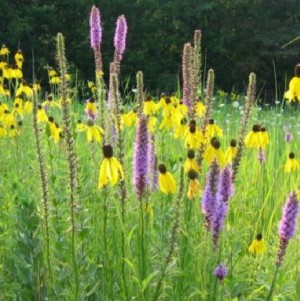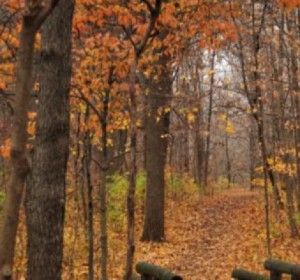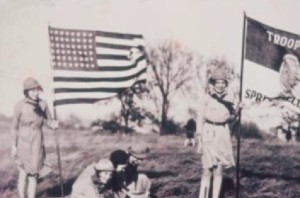Throwback Thursday – LINCOLN MEMORIAL GARDEN – A DESIGNED LANDSCAPE AND RESTORATION
This post was initially published in the SER MWGL newsletter in September 2011.
Seventy-five years ago while Lake Springfield was being constructed as a depression-era Work Progress Administration (WPA) project, a local civic leader, Harriet Knudson, asked the City of Springfield, Illinois to set aside land at the new lake for a garden that she envisioned as a “living memorial to Abraham Lincoln.” It would contain plants from the three states (Kentucky, Indiana, and Illinois) that Lincoln lived in and would be called Lincoln Memorial Garden. Mrs. Knudson recruited the Garden Clubs of Illinois to sponsor the project and then enlisted the services of Jens Jensen, one of the foremost landscape architects of the period, to design the Garden.
Prior to designing Lincoln Memorial Garden, Jensen had done extensive landscaping in the Chicago area including the Garfield Park Conservatory, Columbus and Humboldt Parks, and estates for wealthy Chicagoans along Lake Michigan’s north shore. Jensen’s other work included the estates of Henry and Edsel Ford in Michigan, his folk school The Clearing located in Door County Wisconsin, and hundreds of other public and private designs throughout the Midwestern United States.
Jensen was also one of the Midwest’s earliest environmentalists. He championed causes such as the preservation of the Indiana Dunes, establishment of the Cook County Forest Preserve District, and setting aside outstanding natural areas for an Illinois State Park System. Jensen’s landscape designs reflected his familiarity and knowledge of the Midwest’s prairies, woodlands, and wetlands. Many natural features of these native ecosystems have been incorporated into Jensen’s landscape designs.
The original site of Lincoln Memorial Garden consisted of 0.26 km2 of open pasture that was drained by several small intermittent streams. These streams flowed towards Sugar Creek that was impounded to construct Lake Springfield. In essence, Jensen had a blank canvas on which to begin his work.
Jensen’s design for the Lincoln Memorial Garden consisted of a network of lanes and trails anchored by eight “council rings”, which consisted of large stone circles used for group gatherings. Jensen’s plantings were located along these lanes and around the council rings.
In his book The Clearing (Jensen 1949), Jensen spoke about his landscape design and vision for the Garden:
The Lincoln Garden has been planned on large scale, in keeping with the Country of which the garden is a part. Certain plants are used in large masses so to emphasize their beauty and give a feeling of greatness. It will be a real inspiration to see hundreds of our native crabapples in bloom in a sunlit lane, backed by the deep and mysterious shadows of the woodlands, or the fleeting blossoms of plums or shad entwined with the falling snowflakes of a belated storm in late April as a true sign of the arrival of spring, of life resurrected.
I cannot conceive of anything more poetic, more full of love, than a walk through one of these lanes vibrating with the beauty of our native land when in bloom. Beauty is a fleeting thing – it comes and goes – and so it must.
The lower levels along the margin of Lake Springfield have been dedicated to our lovely sun loving flowers. Thousands of lilies, phlox, and other friends of the open lowlands will greet you in festive array and speak of the beauty the pioneer beheld when first entering Illinois land, a real tapestry of living colors reflected in the blue waters of the lake.
The higher elevations are covered with trees. Here one may seek solitude and repose, and find joy in the carpets of woodland flowers. Many of the trails have been named after these flowers and along the trails masses of the flower for which the trails were named will greet the visitor and call him on and on.
Plantings at the Garden began on November 14, 1936 with the Boy Scouts and Girl Scouts planting the first acorns. Plantings continued in earnest with garden clubs from throughout Illinois visiting the Garden and planting wildflowers and trees under the direction of Jens Jensen and Mrs. Knudson. Plantings continue today as additional or replacement plants are added as needed.
After 75 years, the Garden has begun to mature and in essence is an idealized microcosm of the Midwest United States landscape, containing prairie restorations, a cypress grove, silver maple and cottonwood wetlands, oak hickory forests, and a wide variety of other indigenous species. As with any restoration effort, certain problems have been encountered as the landscape matures. The foremost problem we currently face is the invasion of non-native plants.
Chief among the non-native woody species is bush or amur honeysuckle (Lonicera maackii), Japanese honeysuckle (Lonicera japanica), multiflora rose (Rosa multiflora), and to a lesser extent, Common Privet (Ligustrum vulgare), and Russian Olive (Elaeagnus umbellata). Herbaceous non-native plant species include dame’s rocket (Hesperis matronalis), goose-necked loosestrife (Lysimachia clethroides), and garlic mustard (Alliaria petiolata).
Bush honeysuckle is our most serious problem within the Lincoln Memorial Garden. The Garden is located in a semi-rural area on the main body of Lake Springfield. “Common areas” surround most residential areas along the lake shoreline. The “common areas” are unmanaged and have become a weedy mix of pioneering black locust with an understory of mostly bush oneysuckle with Japanese honeysuckle on the sunny edges. The Garden is also urrounded by these “common areas” that serve as a source of bush honeysuckle and other non-native plant seeds. Attempts to control bush honeysuckle within the Garden focus on a variety of management practices including cut surface herbicide treatment, wholesale cutting by work parties, and some burning. We currently are far behind and a major effort is needed gain control of bush honeysuckle.
Japanese honeysuckle is a bit less aggressive than bush honeysuckle and thrives in sunny areas, climbing and wrapping up small crabapples, dogwoods, and woody shrubs. Our main method of treatment for removal of Japanese honeysuckle is to apply Roundup in late fall (late November or early December), on a plus 50oF day, after the host tree or bush has lost all its foliage, and the Japanese honeysuckle is still green and growing.
Control of other woody species is mainly accomplished through cut surface herbicide treatment of stumps and occasional burns. Control of herbaceous non-native plant species is accomplished mainly by pulling and then destroying the plants to make sure there are no seeds left. Garlic mustard is super aggressive and spreads quickly. Once again, “common areas” around the lake are a rich seed source of non-native herbaceous plants. County and municipal mowers and line clearance crews pick up these seeds in their tires while mowing roadsides and under power lines and spread the plant throughout the area. We check the Garden each spring by walking every square meter of more than 0.4 km2 of the Garden’s grounds and the entire watershed. Streambanks and deer runs are common locations for finding new plants. By finding and pulling these plants before they have a chance to seed and spread we have kept garlic mustard from gaining a foothold in the Garden.
We also have to battle succession at the Garden. Sugar maples would eventually take over the entire Garden if they were not kept in check with a combination of fire and cutting. Sassafras also threatens newly planted hawthorn. Shingle oaks invade within the prairies. Cottonwoods invade and attempt to crowd out all other growth in newly planted wetlands.
Control of non-natives and aggressive native plants is a constant battle to keep Jensen’s design for the Garden intact. He realized that certain plants belonged with and were found in association with others and his early restoration attempts were well intentioned. However, Jensen may not have realized the amount of maintenance that would be required to keep his landscape designs viable. One of the country’s leading Jensen experts, University of Michigan professor, Robert Grese, speaking in an IEW magazine interview (Brown 2011), summarized the problems faced by the Lincoln Memorial Garden and other managers of Jensen landscapes: “The places that were, for him, early experiments in ecological restoration have been particularly vulnerable to invasive exotic species. It’s a lesson in humility, in how such spaces need ongoing management to maintain the design.”
Literature Cited
Jensen, J. 1949. The Clearing. R.F. Seymour Publishing.
Brown, J. R. 2011. Interview with Robert Grese. VIEW magazine, summer 2011.
Jim Matheis, Lincoln Memorial Garden
